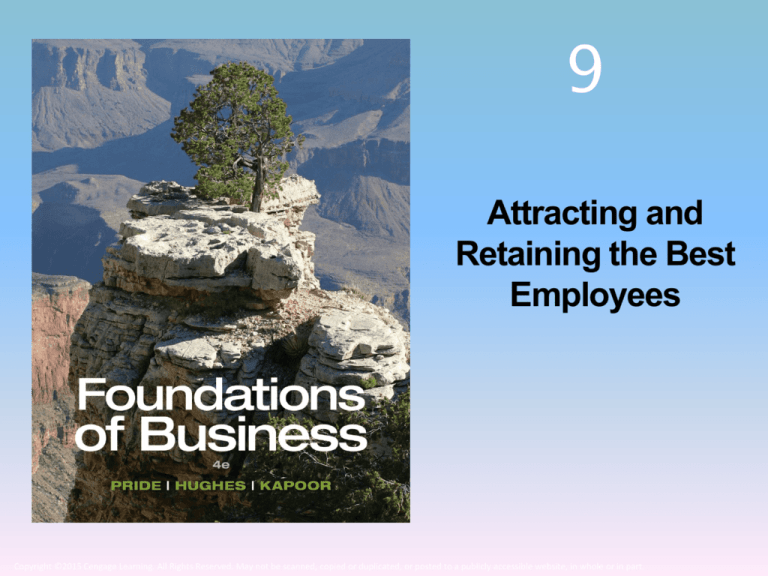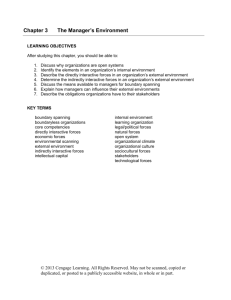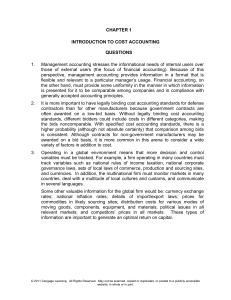
9
Attracting and
Retaining the Best
Employees
Copyright ©2015 Cengage Learning. All Rights Reserved. May not be scanned, copied or duplicated, or posted to a publicly accessible website, in whole or in part.
Human Resources Management (HRM)
All the activities
involved in acquiring,
maintaining, and
developing an
organization’s human
resources
© VIOREL SIMA/SHUTTERSTOCK
Copyright ©2015 Cengage Learning. All Rights Reserved. May not be scanned, copied or duplicated, or posted to a publicly accessible website, in whole or in part.
2
HRM Activities: An Overview
HRM
Activities
Acquiring
Maintaining
Developing
Copyright ©2015 Cengage Learning. All Rights Reserved. May not be scanned, copied or duplicated, or posted to a publicly accessible website, in whole or in part.
3
HRM Activities: Acquiring
Planning
Job Analysis
Recruiting
Selection
Orientation
Copyright ©2015 Cengage Learning. All Rights Reserved. May not be scanned, copied or duplicated, or posted to a publicly accessible website, in whole or in part.
4
Planning
© IOFOTO/SHUTTERSTOCK
The development
of strategies to
meet a firm’s
future human
resources needs
Copyright ©2015 Cengage Learning. All Rights Reserved. May not be scanned, copied or duplicated, or posted to a publicly accessible website, in whole or in part.
5
Planning
Forecast
Human
Resources
Demand
Forecast
Human
Resources
Supply
Match Supply
With Demand
Copyright ©2015 Cengage Learning. All Rights Reserved. May not be scanned, copied or duplicated, or posted to a publicly accessible website, in whole or in part.
6
Planning: Forecasting Human
Resources Demand
What are the major internal and
external factors you see affecting the
demand for human resources in
organizations?
Can organizations affect or
control these factors?
Copyright ©2015 Cengage Learning. All Rights Reserved. May not be scanned, copied or duplicated, or posted to a publicly accessible website, in whole or in part.
7
Planning: Forecasting Human
Resources Supply
Two useful techniques for forecasting
human resources supply:
Replacement chart: a list of key
personnel and their possible
replacements within a firm.
Skills inventory: a computerized data
bank containing information on the skills
and experience of all present employees
Copyright ©2015 Cengage Learning. All Rights Reserved. May not be scanned, copied or duplicated, or posted to a publicly accessible website, in whole or in part.
8
Planning: Matching Supply with Demand
If supply is greater than demand, then the
firm must prepare plans to reduce the
workforce through
Layoffs
Attrition
Early retirement
Firing
Copyright ©2015 Cengage Learning. All Rights Reserved. May not be scanned, copied or duplicated, or posted to a publicly accessible website, in whole or in part.
9
Cultural Diversity in Human Resources
Differences among people in a workforce
owing to race, ethnicity, and gender
© KURHAN/SHUTTERSTOCK
Copyright ©2015 Cengage Learning. All Rights Reserved. May not be scanned, copied or duplicated, or posted to a publicly accessible website, in whole or in part.
10
Coping with Diversity Challenges
Train managers to
value diversity
• Facilitate support groups
for immigrants
© C.W.GRIFFIN / MCT / LANDOV
Recruit minority
employees and train
them to be managers
• Teach English as a
second language
© YURI ARCURS/SHUTTERSTOCK
Copyright ©2015 Cengage Learning. All Rights Reserved. May not be scanned, copied or duplicated, or posted to a publicly accessible website, in whole or in part.
11
Job Analysis
A systematic procedure for studying jobs to
determine their various elements and
requirements
Job
description
A list of the elements that make up a
particular job
• Duties, responsibilities, working conditions,
the tools and equipment used on the job
A list of the qualifications required
to perform a particular job
Job
specification • Skills, abilities, education, and
experience
Copyright ©2015 Cengage Learning. All Rights Reserved. May not be scanned, copied or duplicated, or posted to a publicly accessible website, in whole or in part.
12
Recruiting, Selection, and Orientation
Recruiting
The process of
attracting qualified
job applicants
© LIGHTSPRING/SHUTTERSTOCK
Copyright ©2015 Cengage Learning. All Rights Reserved. May not be scanned, copied or duplicated, or posted to a publicly accessible website, in whole or in part.
13
Advantage
Brings fresh
perspectives to the
company
© IMAGE SOURCE / ALAMY
External Recruiting
Disadvantages
May be expensive
May cause
resentment among
existing employees
Copyright ©2015 Cengage Learning. All Rights Reserved. May not be scanned, copied or duplicated, or posted to a publicly accessible website, in whole or in part.
14
Internal Recruiting
Advantages
Motivates current
employees
Helps retain
quality personnel
Disadvantages
Cost of filling the vacant position
Cost of training another employee
© YURI ARCURS/SHUTTERSTOCK
Copyright ©2015 Cengage Learning. All Rights Reserved. May not be scanned, copied or duplicated, or posted to a publicly accessible website, in whole or in part.
15
Selection
The process of
gathering information
about applicants and
then using that
information to choose
the most appropriate
applicant
Copyright ©2015 Cengage Learning. All Rights Reserved. May not be scanned, copied or duplicated, or posted to a publicly accessible website, in whole or in part.
© NEVENA RADONIA/SHUTTERSTOCK
Recruiting, Selection, and Orientation
16
Selection
Means of obtaining information about
applicants’ qualifications
Employment
Applications
Employment
Tests
References
Interviews
Assessment
Centers
Copyright ©2015 Cengage Learning. All Rights Reserved. May not be scanned, copied or duplicated, or posted to a publicly accessible website, in whole or in part.
17
Recruiting, Selection, and Orientation
Orientation
The process of acquainting
new employees with an
organization
© NEVENA RADONJA/SHUTTERSTOCK
May be brief and informal
or long and formal
Copyright ©2015 Cengage Learning. All Rights Reserved. May not be scanned, copied or duplicated, or posted to a publicly accessible website, in whole or in part.
18
HRM Activities: Maintaining
Benefits
Employee
Relations
Compensation
Copyright ©2015 Cengage Learning. All Rights Reserved. May not be scanned, copied or duplicated, or posted to a publicly accessible website, in whole or in part.
19
Compensation
Compensation
The payment employees
receive in return for their
labor
Compensation system
The policies and
strategies that determine
employee compensation
© ARKA38/SHUTTERSTOCK
Copyright ©2015 Cengage Learning. All Rights Reserved. May not be scanned, copied or duplicated, or posted to a publicly accessible website, in whole or in part.
20
Designing an effective
Compensation System
Designing an effective compensation system
requires three separate management decisions
Wage
level
• The firm’s choice to position its general level
of pay at, above, or below the market wage
for an industry or a geographic area
Wage
structure
• The internal compensation structure
that sets the relative pay levels for all
the positions in the firm
Individual • The specific payments
individual employees
wages
receive
Copyright ©2015 Cengage Learning. All Rights Reserved. May not be scanned, copied or duplicated, or posted to a publicly accessible website, in whole or in part.
21
Compensation
© NEVENA RADONIA/SHUTTERSTOCK
Comparable worth
A concept that seeks equal compensation
for jobs requiring about the same level of
education, training, and skills
Copyright ©2015 Cengage Learning. All Rights Reserved. May not be scanned, copied or duplicated, or posted to a publicly accessible website, in whole or in part.
22
Types of Compensation
Hourly wage
Incentive payments
Weekly or monthly
salary
Lump-sum salary
increases
Commissions
Profit sharing
Copyright ©2015 Cengage Learning. All Rights Reserved. May not be scanned, copied or duplicated, or posted to a publicly accessible website, in whole or in part.
23
Employee Benefits
Rewards in addition to regular
compensation that are provided indirectly
to employees
Pay for time not worked
Other unusual benefits
Company cafeterias
Health, life, and dental
insurance
Stock-option plans
Pension and retirement
programs
Tuition-reimbursement
plans
Workers’ compensation
insurance
Child-care services
Unemployment insurance
Copyright ©2015 Cengage Learning. All Rights Reserved. May not be scanned, copied or duplicated, or posted to a publicly accessible website, in whole or in part.
24
Flexible Benefit Plans
A compensation
plan whereby an
employee receives
a predetermined
amount of benefit
dollars to spend on
a package of
benefits he or she
has selected to
meet individual
needs
Advantages
Disadvantages
Copyright ©2015 Cengage Learning. All Rights Reserved. May not be scanned, copied or duplicated, or posted to a publicly accessible website, in whole or in part.
25
HRM Activities: Training and
Development
Employee training
• Teaching operations
employees how to do their
present jobs more effectively
and efficiently
Management
development
• Preparing managers to
assume increased
responsibility in both present
and future positions
Copyright ©2015 Cengage Learning. All Rights Reserved. May not be scanned, copied or duplicated, or posted to a publicly accessible website, in whole or in part.
26
Training and Development Methods
On-the-job
Classroom
teaching and
lectures
Simulation
Conferences
and
seminars
Role-playing
Copyright ©2015 Cengage Learning. All Rights Reserved. May not be scanned, copied or duplicated, or posted to a publicly accessible website, in whole or in part.
27
Performance Appraisal
Uses
Lets workers know
how they are doing
and how they can
do better
Provides the basis
for distributing
rewards
Helps the organization monitor
employee selection, training, and
development activities
© MICHAL KWALSKI/SHUTTERSTOCK
Copyright ©2015 Cengage Learning. All Rights Reserved. May not be scanned, copied or duplicated, or posted to a publicly accessible website, in whole or in part.
28
Performance Feedback Approaches
Tell-and-sell
Tell-and-listen
Problemsolving
• Superior tells the employee how well or poorly the
employee is performing and attempts to persuade
the employee to accept the evaluation
• Supervisor tells the employee about his or her
performance and then gives the employee a
chance to respond
• Employee evaluates own performance and sets
own goals; supervisor offers comments and goals
are mutually established
Mixed interview
• Tell-and-sell to communicate administrative
decisions; problem-solving to discuss employeedevelopment issues and future goals
360-degree
evaluation
• Employee is provided feedback from evaluations
by his superiors, peers, and subordinates
Copyright ©2015 Cengage Learning. All Rights Reserved. May not be scanned, copied or duplicated, or posted to a publicly accessible website, in whole or in part.
29
The Legal Environment of HRM
Copyright ©2015 Cengage Learning. All Rights Reserved. May not be scanned, copied or duplicated, or posted to a publicly accessible website, in whole or in part.
© NEVENA RADONIA/SHUTTERSTOCK
National Labor Relations Act and LaborManagement Relations Act (1935)
Established a collective-bargaining
process in labor-management relations
as well as the National Labor Relations
Board (NLRB)
Labor-Management Relations Act (1947)
Provides a balance between union power
and management power
30
The Legal Environment of HRM
© NEVENA RADONIA/SHUTTERSTOCK
Fair Labor Standards Act (1938)
Established a minimum wage and an overtime
pay rate for employees working more than
forty hours per week
Exemptions: Managers and professionals
Copyright ©2015 Cengage Learning. All Rights Reserved. May not be scanned, copied or duplicated, or posted to a publicly accessible website, in whole or in part.
31
The Legal Environment of HRM
Copyright ©2015 Cengage Learning. All Rights Reserved. May not be scanned, copied or duplicated, or posted to a publicly accessible website, in whole or in part.
© KEKO-KA/SHUTTERSTOCK
Equal Pay Act (1963)
Specifies that men and women
who do equal jobs must be paid
the same wage; differences only
legal if due to seniority,
qualifications, or performance
32
The Legal Environment of HRM
Title VII of the Civil Rights Act (1964)
Prohibits discrimination in employment
practices based on sex, race, color,
religion, or national origin
Age Discrimination in Employment Act
(1967-1986)
Prohibits personnel practices that
discriminate against people aged 40 and
older
Copyright ©2015 Cengage Learning. All Rights Reserved. May not be scanned, copied or duplicated, or posted to a publicly accessible website, in whole or in part.
33
The Legal Environment of HRM
Occupational Safety and Health Act (1970)
Regulates the degree to which employees can
be exposed to hazardous substances and
specifies the safety equipment that the
employer must provide
Worker Adjustment and Retraining
Notification (WARN) Act (1988)
Requires employers to give employees sixty
days’ notice regarding plant closure or the
layoff of fifty or more employees
Copyright ©2015 Cengage Learning. All Rights Reserved. May not be scanned, copied or duplicated, or posted to a publicly accessible website, in whole or in part.
34
The Legal Environment of HRM
Employment
Retirement Income
Security Act (1974)
Regulates company
retirement programs
and provides a
federal insurance
program for
retirement plans that
go bankrupt
Copyright ©2015 Cengage Learning. All Rights Reserved. May not be scanned, copied or duplicated, or posted to a publicly accessible website, in whole or in part.
© KURHAN/SHUTTERSTOCK
35
The Legal Environment of HRM
Civil Rights Act (1991)
Facilitates employees’ suing employers for
sexual discrimination and collecting punitive
damages
Americans with Disabilities Act (1990)
Prohibits discrimination against qualified
individuals with disabilities
Requires employers to provide employees with
reasonable accommodation
Copyright ©2015 Cengage Learning. All Rights Reserved. May not be scanned, copied or duplicated, or posted to a publicly accessible website, in whole or in part.
36
Reasonable Accommodation
Any modification or
adjustment to a job or work
environment to enable a
qualified, disabled
employee to perform a
central job function
© AUREMAR/SHUTTERSTOCK
How, do you think, do employers
decide what constitutes a
reasonable accommodation for a
disabled employee?
Copyright ©2015 Cengage Learning. All Rights Reserved. May not be scanned, copied or duplicated, or posted to a publicly accessible website, in whole or in part.
37
The Legal Environment of HRM
Copyright ©2015 Cengage Learning. All Rights Reserved. May not be scanned, copied or duplicated, or posted to a publicly accessible website, in whole or in part.
© NEVENA RADONIA/SHUTTERSTOCK
Family and Medical Leave Act (1993)
Requires an organization with 50 or
more employees to provide up to
12 weeks of leave without pay
on the birth (or adoption)
of an employee’s child or
if an employee or his
or her spouse, child,
or parent is
seriously ill.
38
The Legal Environment of HRM
Affordable Care Act (2010)
Requires an organization with fifty or more
employees to make health insurance
available to employees or pay an
assessment, gives employees the right to
buy health insurance from another
provider
Copyright ©2015 Cengage Learning. All Rights Reserved. May not be scanned, copied or duplicated, or posted to a publicly accessible website, in whole or in part.
39
Affirmative Action
A series of executive orders issued by the
President of the US
Applies to all employers with fifty or more
employees holding federal contracts in excess
of $50,000
Such employers must
• Actively encourage job applications
from members of minority groups
• Hire qualified employees from minority
groups not fully represented in the
organization
Copyright ©2015 Cengage Learning. All Rights Reserved. May not be scanned, copied or duplicated, or posted to a publicly accessible website, in whole or in part.
40
CLASS EXERCISE
Discuss the contrasting viewpoints on affirmative action
policies expressed in the following articles:
“Affirmative Action vs. White Privilege” at
http://www.ebony.com/news-views/affirmative-actionvs-white-privilege-119#axzz2Kano5YXj
“Race and College Admissions, Facing a New Test by
Justices” at
http://www.nytimes.com/2012/10/09/us/supreme-courtto-hear-case-on-affirmativeaction.html?pagewanted=all&_r=1&
“Affirmative action: Good or harmful?” at
inamerica.blogs.cnn.com/2012/10/10/affirmativeaction-good-or-harmful/
Copyright ©2015 Cengage Learning. All Rights Reserved. May not be scanned, copied or duplicated, or posted to a publicly accessible website, in whole or in part.
41









